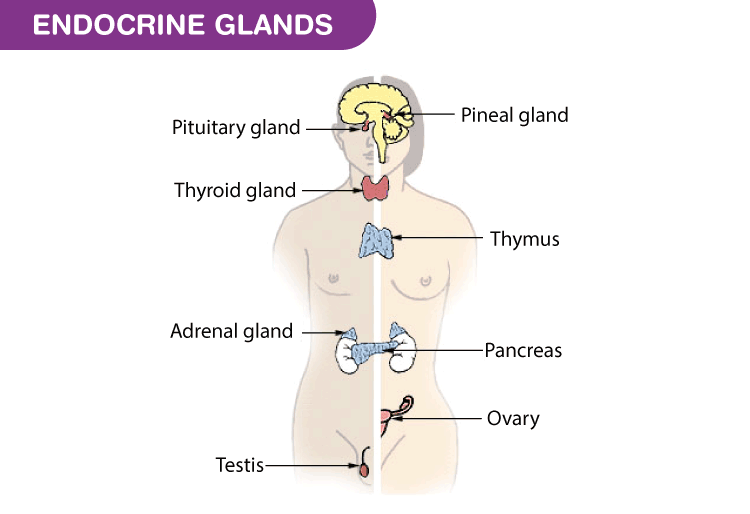5 Endocrine Glands and What They Do

What is Endocrine System?
Hormones are chemicals that affect a lot of the bodily functions ranging from hunger, reproduction and growth to much more complicated functions like human emotions and behaviour. These hormones are produced in our body through nine primary glands and these glands, along with other organs that provide auxiliary functions make up the endocrine system.
Let us have a detailed look at the endocrine system notes and explore the major endocrine glands in the human body.

Unlike exocrine glands(sweat, salivary), endocrine glands secrete their respective substances directly into the bloodstream rather than through a duct. These endocrine glands belong to the body's control system and they produce hormones which help to regulate the functions of cells and tissues. Some glands are specific to either male (testes) or female (ovaries)
Major Endocrine Glands
Pituitary gland
Enclosed deep within the skull, the pituitary gland is the size of a pea. It hangs on a stalk at the base of the brain. It consists of an anterior portion that produces hormones and a posterior portion that has many neural links. This gland is regarded as the master gland as it controls the functions of all the other glands (such as the adrenal, thyroid glands) in the endocrine system. The pituitary gland stimulates the adrenal gland to secrete cortisol, a steroid hormone controls a range of activities from controlling the body's metabolism to stimulating blood pressure. The pituitary gland also secretes prolactin, which stimulates the production of milk.
Thyroid gland
The thyroid glands can be found at the front of the neck. It sits low in the throat, between the windpipe. Brownish red, it has blood vessels coursing through it. It secretes hormones that are collectively called thyroid hormones. The most prominent are T3 and T4, which influence the body's rate of metabolism.
Parathyroid glands
The parathyroid glands consist of four small glands that are located behind the thyroids in the neck. They influence the calcium levels in the body by producing a hormone called Parathyroid Hormone. Sometimes, when the gland produces excess parathyroid hormones, it can have negative effects such as brittle bones and kidney stones.
Adrenal glands
The adrenal glands sit atop the kidneys and are no larger than a walnut. These glands produce over 150 hormones that regulate different functions in the body. The most well known is Adrenaline, which triggers the flight or fight response. In other words, this is a stress hormone that helps the organism to either face a dangerous situation or to avoid it altogether. It does this by:
- Increasing blood sugar levels
- Increasing the blood supply to the muscles, particularly to the limbs.
- Dilating the pupils
- Increasing the heart rate
- Tightening the jaw muscles.
Pancreas
The pancreas is exocrine as well as an endocrine gland that sits behind the stomach. It is roughly 6 inches long and rather flat. The pancreas has two primary roles to play:
- Producing digestive enzymes
- Producing hormones such as insulin and glucagon.
Insulin is produced by the β cells in the pancreas and it helps in regulating the blood glucose levels in the body from getting too high. As we are all aware, the lack of insulin causes type 1 and type 2 diabetes. The hormone glucagon is produced by α cells of the pancreas and it helps the body to prevent the glucose levels from dropping too low. Lack of glucagon leads to hypoglycemia. Another key difference between the two is insulin becomes active when the blood glucose levels are high, and glucagon become active only when blood glucose levels are low.
Gonads
Some glands are specific to males or females. For instance, the ovaries are specific to females and are located in the pelvic cavity. While the testes are specific to males. Ovaries produce estrogen that is important for reproduction and female sex characteristics. Testes produce testosterone that is responsible for male sex characteristics. Also, it results in increased muscle mass and body hair.
Pineal gland
The pineal gland is located between the two halves of the brain. It was also known as the "third eye" for most of history due to its location in the brain and its connection with light.
It produces a hormone known as melatonin which influences the body's internal clock. Also known as the Circadian Rhythm, it influences the body's sleep/wake cycle. Its effects are not really noticeable unless the individual is sleep-deprived. Factors such as jet lag, or working the night shift has a more noticeable effect on an individual because Circadian rhythm tends to coincide with the day and night cycle. That's why individuals who work during the night find it hard to fall asleep during the day, and consequently stay awake for the next night.
Recommended Video:

Register at BYJU'S for endocrine system notes. Refer to these notes for reference.
5 Endocrine Glands and What They Do
Source: https://byjus.com/biology/endocrine-glands/